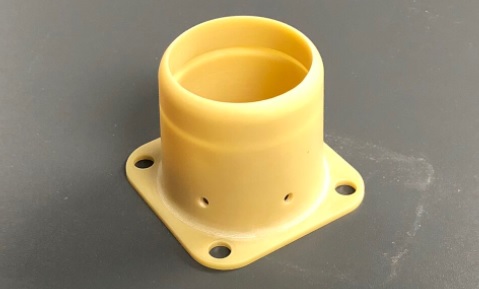Benefits of Scale moving from Machined Prototypes to Molded Production in Thermoplastics
Hi-Tech helps our Customers utilize thermoplastics in Stock Shapes to scale up parts and assemblies from the Prototype Phase to hard tooling and the higher volumes of Injection Molding. This article will cover a basic cost profile and the benefits of molding as the volumes increase. The time and cost information is based off an actual application that Hi-Tech first machined and is now molding.
For this discussion, we’ll assume the material is Torlon, a high temperature thermoplastic available in Stock and Pellet form. Hi-Tech would purchase sheet stock from one of several distributors and use a CNC mill to machine 100% of the geometry to print. In this case, the manufacturing process started with a fixture that was used to generate 1 piece per operation and there are two operations requiring two set ups. The part geometry requires a significant amount of machining. Below is the cost profile based on the above information and this is typical for quantities of 10-30 pcs.
Cost Profile #1: Low Quantity Machining
Total Price of Part: $315.00
Cost of Material in Part: 64%
Cost of Labor in Part: 36%
This lower quantity manufacturing technique is suitable, as the up front tooling cost is low and as long as volume doesn’t exceed 30 pcs per lot or approx. 120 pcs per year.
One to two years into production, the volumes increase and the lot quantities are closer to 100 pcs or approx. 400 pcs per year. At this point, a good option to reduce costs is to produce more parts per set up. Hi-Tech increased fixture cavitation that allows 4 parts per set-up. The cost to move to this type of production set up is minor, just the cost of the fixture and some minor programming updates. Below is the cost profile based on this new, slightly higher machining rate or capability
Cost Profile #2: Medium Quantity Machining
Total Price of Part: $280.00
Cost of Material in Part: 59%
Cost of Labor in Part: 41%
Cost Savings: $35.00 per piece or 11%
In Stock Shapes, generally the material pricing stays constant. Volume increases on stock shapes material have to be very significant to change the price, thus all of the cost savings in this second profile comes from reduction in labor.
Two years into production, the volumes increase above 400 pcs per year and now it makes sense to move to hard tooling and injection molding. As Hi-Tech is already a certified Torlon molder, the only costs associated with this move is the Injection Mold Tooling. Assume the Injection Mold Tooling is $40,000 and the annual quantities are now 1000 pcs per year. The part geometry and mold design are such that there is still some post mold machining required. Below is the cost profile for this third cost scenario.
Cost Profile #3: Low Quantity Injection Molding
Total Price of Part: $63.00
Cost of Injection Mold: $40,000.00
Cost of Material in Part: 15%
Cost of Labor in Part: 85%
Cost Savings over 2nd profile: $217.00 per piece or 78%
Injection Mold Tool Payback: Less than 3 months
The move from machining to molding has resulted in a significant price reduction and the cost of the Injection Mold Tooling is paid off relatively quickly. Below are a few summary points:
1 – Machining Thermoplastics is a viable approach to producing parts at low volumes.
2 – As volumes increase, some efficiencies in Set-Up and Operations can be realized, but generally the material cost stays the same.
3 – Even when 100% of the final geometry can not be molded in, Injection Molding still offers a significant reduction in cycle time. The savings would be higher if 100% of the geometry could be molded in.
4 – The material cost from Machining to Molding went down. In Torlon and Ultem, the bar or sheet stock costs 3 to 4 times that of the same volume required for Injection Molding.
Hi-Tech has experience in machining low quantities of Thermoplastic components and molding high quantities of Thermoplastic components. We hope that the above article helps to bring to light some of the advantages of moving to different manufacturing techniques when volumes warrant it.
If you have any questions, please go to Contact and send us a note. Thanks for your time.

